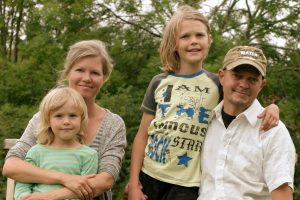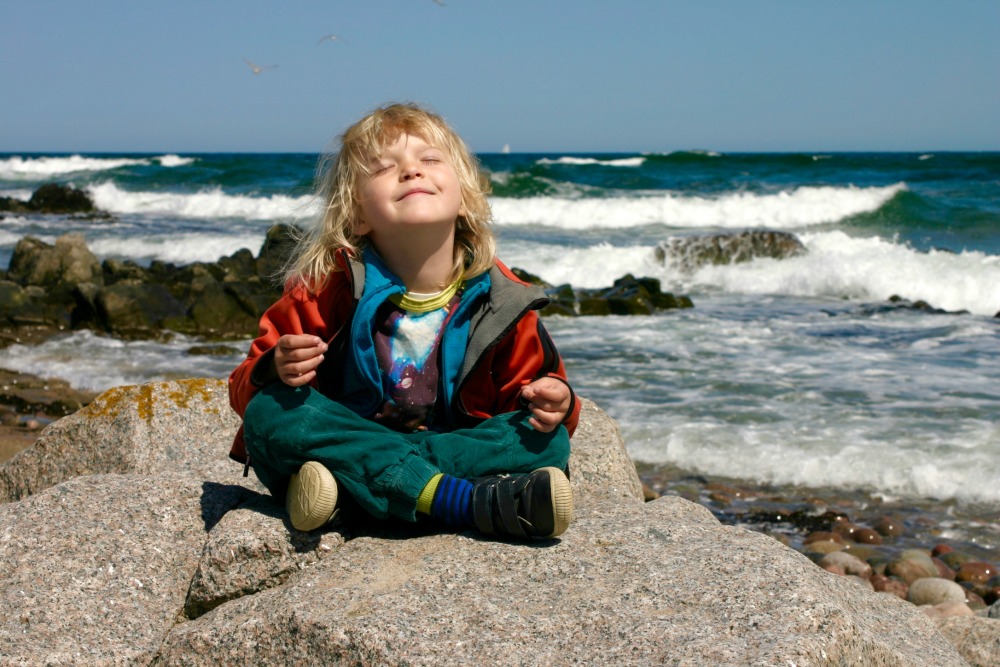It took me a long time to realize why the present moment was a helpful place to hang out. I can even recall as an anxious kid how my mind worked “I’m going to fail this test, then fail out of school, never get into college, probably die homeless and alone under a bridge, and no one will come to my funeral” was a not so rare thought for me. But when I learned about mindfulness and staying in the moment, I realized that I could still prepare for the future, like just studying for the darn test, without getting caught up in story of how badly it could go.
The future is where anxiety usually resides, for both adults and kids. Think about it, most of the horror stories we tell ourselves are about events that haven’t even, and probably will never happen! Mark Twain even once said “I’ve experienced many terrible things in my life… only a few of which actually ever happened.”
Taking a Mindful Seat
Our thoughts are often racing off to the past and future, feeling overwhelmed by our emotions, or distracted by senses and sensations. But we can teach ourselves and our kids to check in to the present moment by getting in touch with our senses and emotions, thoughts and the actions that we want to take, and then learn how to manage that anxiety more effectively. I call it taking a mindful SEAT. Begin by sitting up, and taking a few calming breaths, then check in with yourself.
S is for Sensations
Start by checking in with your body. What sensations are you noticing right now?
E is for Emotions
What emotions are present in this very moment?
A is for Actions
What do you feel like doing in this moment? Any urges or impulses to action?
T is for Thoughts
What thoughts are present in this moment?
Something to Try
Try this together with your child, or invite them to write down a few words or even pictures to describe what’s happening in each part of the mindful SEAT. Just putting it on paper or sharing out loud, we start to get some perspective. Encourage kids to take a Mindful SEAT during transition times, or at potentially anxiety triggering moments in the day and in their lives. It can be as simple as:
Sensation: I feel my heart pounding.
Emotion: I’m scared.
Action: I want to to scream!
Thought: There must be something wrong, I’m going to fail the test!
Once we’ve identified these sensations as sensations, emotions as emotions, thoughts and actions as just those, we can empower ourselves and our kids to get some perspective and make a different choice, like some simple breathing or distraction to turn of the panic.
The Miracle Grow Breath
I’ve been seeing an adorable nine-year-old boy, Max, as a therapist for about four years now. A sweet and sensitive child, he took to mindfulness almost immediately, having a family who was already practicing some fun and simple breathing and visualizations at home and were looking for support with his anxiety. We made up all kinds of new practices as we went, integrating movement and a whole lot of laughter into our sessions over time, that he would take home and share with his family and friends.
A few years in, he came in looking different. He was quiet and reserved, and slumped onto my couch avoiding my eyes. His mother joined him and I knew something was up. It turned out, his mother explained, that his once-best friend at school had turned on him, taunting him each day at recess while the teachers, who were supposed to be watching the kids social lives, were actually watching their own social media on their phones.
“How do you feel when Theo treats you that way?” I gently asked, leading, a bit self-consciously, with the classic therapist question. Max, eyes downcast, simply shrugged off my question, continuing to look defeated and downright deflated. His mom, who had joined us for the session leaned in. “Max, can you show us what you feel like?” Max sighed, sat up straight, and then crumpled over.
“You look,” his mother suggested, “like a wilted flower.”
With his brain and body flooded with emotion sadness and shame, logic and language failed, but his body language told the story of the trauma.
“How do you think you could feel strong and confident again,” I asked, “Blossoming again, like a freshly watered flower?”
I could see Max listening and thinking, though his body remained slumped at wilted. Then, he took a long deliberate breath in. As his chest rose and expanded he became a bit more upright, and held the posture. On the next breath he sat up straighter still, until by third breath in his shoulders were back, chest expanded, and on the fourth breath his head rose and he smiled. He held out his arms like blossoming petals. “The miracle grow breath!” his mother declared with a smile, and we all had a laugh.
With each inhale, Max had breathed in more confidence, slowly shifting his posture into a confident and radiant pose, transforming how he looked and felt to us, but more importantly to himself. “Let’s try it all together,” I suggested, as the three of us wilted down, and then Max guided us breath by breath until we were sitting, then standing, our minds and bodies blossoming in full confidence.
Breath practices with kids don’t have to be boring, they can be an outlet for creativity and confidence. What’s more, practices like this where we adjust our posture may even change how confident we feel, down to the hormonal level. Max’s Miracle Grow breath can boost the confidence and resilience of any child has experienced a setback—be it bullying, a break up, or a dreaded B-minus.
There’s an (Excellent) App For That
There are a massive number of apps out there teaching meditation, mindfulness and related practices, and easily a few dozen aimed at a younger audience. For the most part, the apps share similar features, and the field is littered with serviceable, if mediocre and uncreative apps.
Thankfully for those of us with kids, or who work with kids, there are a few exceptions out there that can help us parents and professionals feel more ease about handing over a screen to our child when there is “nothing else to do.”
I’ve recently encountered The Mindfulness for Children app, by Danish couple Jannik and Pia Holgersen. Their experience in production, and physiology, but more importantly parenting, suggest a lot of credibility. Long term practitioners themselves, they were hoping to find fun and practical ways to share mindfulness with their own kids, and well, your kids as well. They’ve achieved this with The Mindfulness for Children app.
The app has a simple interface and easy to use features, with a number of types of mediations, primarily adaptations of body scans, visualizations, and simple breathing practices (unfortunately there’s not yet a Hygge practice) that are developmentally appropriate and fun for all ages, to work with challenging emotions and body states.
About the Author: Dr Christopher Willard
 Dr. Christopher Willard (PsyD) is a psychologist and educational consultant based in Boston specializing in mindfulness. He has been practicing meditation for 20 years, and leads workshops nationally and internationally. He currently serves on the board of directors at the Institute for Meditation and Psychotherapy, and is the president of the Mindfulness in Education Network. He has presented at TEDx conferences and his thoughts have appeared in the New York Times, The Washington Post, mindful.org, and elsewhere. He is the author ofChild’s Mind (2010), Growing Up Mindful (2016), Raising Resilience (2017) and three other books. He has three children’s books forthcoming, and teaches at Harvard Medical School. Find out more on drchristopherwillard.com, Facebook, or Twitter.
Dr. Christopher Willard (PsyD) is a psychologist and educational consultant based in Boston specializing in mindfulness. He has been practicing meditation for 20 years, and leads workshops nationally and internationally. He currently serves on the board of directors at the Institute for Meditation and Psychotherapy, and is the president of the Mindfulness in Education Network. He has presented at TEDx conferences and his thoughts have appeared in the New York Times, The Washington Post, mindful.org, and elsewhere. He is the author ofChild’s Mind (2010), Growing Up Mindful (2016), Raising Resilience (2017) and three other books. He has three children’s books forthcoming, and teaches at Harvard Medical School. Find out more on drchristopherwillard.com, Facebook, or Twitter.
About the Creators of Mindfulness for Children: Jannik and Pia Holgersen
 As a qualified psycho-motor therapist, Pia is passionate about helping people help themselves. In her private as well as in her professional life, Pia has gathered the benefits and joy of mindfulness meditation, which she regards as a powerful tool for creating physical and mental stability – a daily life with more inner peace and increased energy. Jannik Holgersen has a background as a freelance TV cameraman and sound engineer. He has 15 years epxerience as a mindfulness practitioner, and has developed and produced several different apps – among them Sound of Bornholm and Sound of Mindfulness.
As a qualified psycho-motor therapist, Pia is passionate about helping people help themselves. In her private as well as in her professional life, Pia has gathered the benefits and joy of mindfulness meditation, which she regards as a powerful tool for creating physical and mental stability – a daily life with more inner peace and increased energy. Jannik Holgersen has a background as a freelance TV cameraman and sound engineer. He has 15 years epxerience as a mindfulness practitioner, and has developed and produced several different apps – among them Sound of Bornholm and Sound of Mindfulness.
Find out more about Jannik and Pia and their work their website, Facebook, Twitter, Youtube, Google+, Instagram, Pinterest, and LinkedIn.



I’m a retired adult but my emotions have often been too big for me to handle. Is there a good app. to help me with short mindfulness sessions?
Try the app referred to in the article. It’s a great one.
Wow, this is so important. I would love to see schools teach mindfulness and all that it entails. I believe it would change the world.